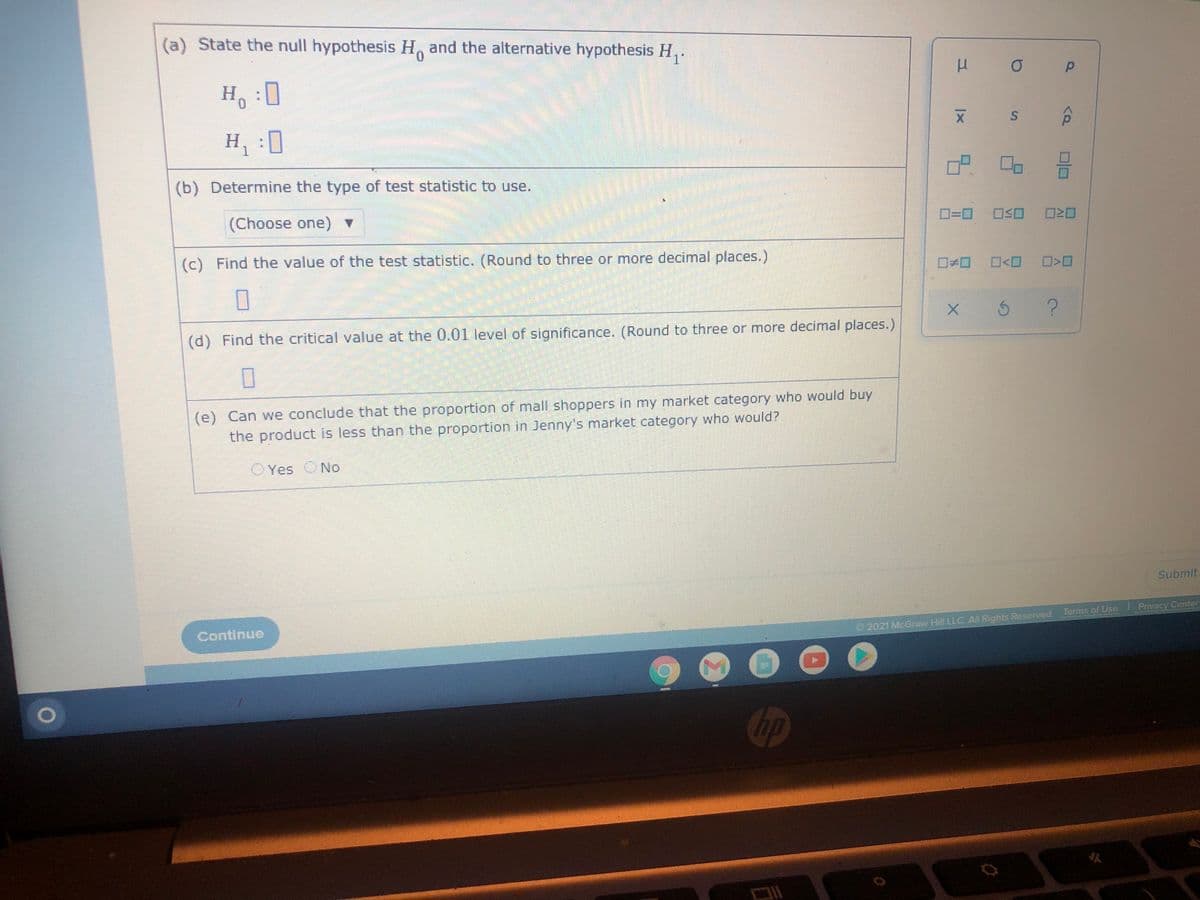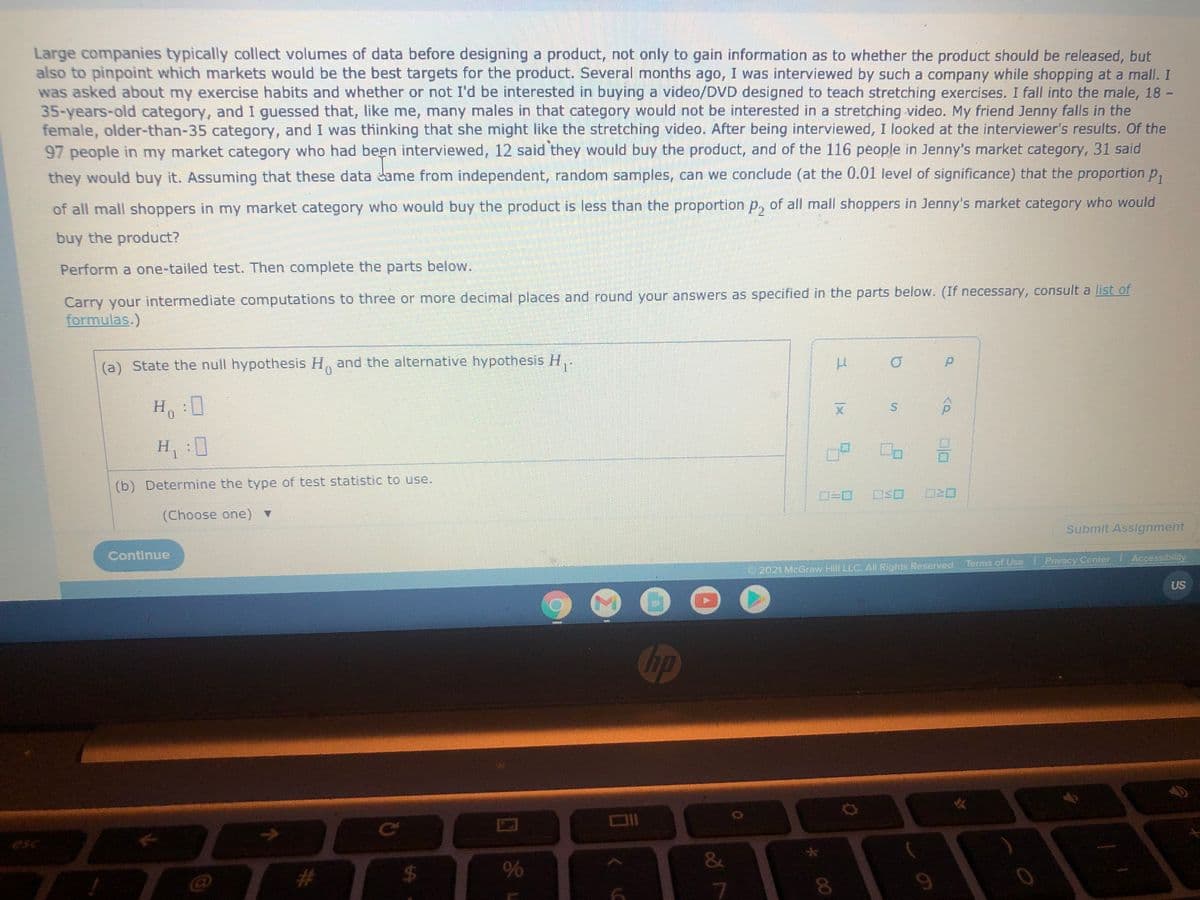Large companies typically collect volumes of data before designing a product, not only to gain information as to whether the product should be released, but also to pinpoint which markets would be the best targets for the product. Several months ago, I was interviewed by such a company while shopping at a mall. was asked about my exercise habits and whether or not I'd be interested in buying a video/DVD designed to teach stretching exercises. I fall into the male, 18 35-years-old category, and I guessed that, like me, many males in that category would not be interested in a stretching video. My friend Jenny falls in the female, older-than-35 category, and I was thinking that she might like the stretching video. After being interviewed, I looked at the interviewer's results. Of the 97 people in my market category who had been interviewed, 12 said they would buy the product, and of the 116 people in Jenny's market category, 31 said they would buy it. Assuming that these data dame from independent, random samples, can we conclude (at the 0.01 level of significance) that the proportion p, of all mall shoppers in my market category who would buy the product is less than the proportion p, of all mall shoppers in Jenny's market category who would buy the product? Perform a one-tailed test. Then complete the parts below. Carry your intermediate computations to three or more decimal places and round your answers as specified in the parts below. (If necessary, consult a list of formulas.) (a) State the null hypothesis H and the alternative hypothesis H,.
Large companies typically collect volumes of data before designing a product, not only to gain information as to whether the product should be released, but also to pinpoint which markets would be the best targets for the product. Several months ago, I was interviewed by such a company while shopping at a mall. was asked about my exercise habits and whether or not I'd be interested in buying a video/DVD designed to teach stretching exercises. I fall into the male, 18 35-years-old category, and I guessed that, like me, many males in that category would not be interested in a stretching video. My friend Jenny falls in the female, older-than-35 category, and I was thinking that she might like the stretching video. After being interviewed, I looked at the interviewer's results. Of the 97 people in my market category who had been interviewed, 12 said they would buy the product, and of the 116 people in Jenny's market category, 31 said they would buy it. Assuming that these data dame from independent, random samples, can we conclude (at the 0.01 level of significance) that the proportion p, of all mall shoppers in my market category who would buy the product is less than the proportion p, of all mall shoppers in Jenny's market category who would buy the product? Perform a one-tailed test. Then complete the parts below. Carry your intermediate computations to three or more decimal places and round your answers as specified in the parts below. (If necessary, consult a list of formulas.) (a) State the null hypothesis H and the alternative hypothesis H,.
Glencoe Algebra 1, Student Edition, 9780079039897, 0079039898, 2018
18th Edition
ISBN:9780079039897
Author:Carter
Publisher:Carter
Chapter10: Statistics
Section10.6: Summarizing Categorical Data
Problem 27PPS
Related questions
Topic Video
Question

Transcribed Image Text:(a) State the null hypothesis H, and the alternative hypothesis H,.
0.
Ho
H,:0
(b) Determine the type of test statistic to use.
D3D0
(Choose one) v
(c) Find the value of the test statistic. (Round to three or more decimal places.)
(d) Find the critical value at the 0.01 level of significance. (Round to three or more decimnal places.)
(e) Can we conclude that the proportion of mall shoppers in my market category who would buy
the product is less than the proportion in Jenny's market category who would?
O Yes No
Submit
0 2021 McGraw Hill LLC All Rights Reserved Terms of Use 1 Pivacy Center
Continue
Chp

Transcribed Image Text:Large companies typically collect volumes of data before designing a product, not only to gain information as to whether the product should be released, but
also to pinpoint which markets would be the best targets for the product. Several months ago, I was interviewed by such a company while shopping at a mall. I
was asked about my exercise habits and whether or not I'd be interested in buying a video/DVD designed to teach stretching exercises. I fall into the male, 18
35-years-old category, and I guessed that, like me, many males in that category would not be interested in a stretching video. My friend Jenny falls in the
female, older-than-35 category, and I was thinking that she might like the stretching video. After being interviewed, I looked at the interviewer's results. Of the
97 people in my market category who had been interviewed, 12 said they would buy the product, and of the 116 people in Jenny's market category, 31 said
they would buy it. Assuming that these data eame from independent, random samples, can we conclude (at the 0.01 level of significance) that the proportion p,
of all mall shoppers in my market category who would buy the product is less than the proportion p, of all mall shoppers in Jenny's market category who would
buy the product?
Perform a one-tailed test. Then complete the parts below.
Carry your intermediate computations to three or more decimal places and round your answers as specified in the parts below. (If necessary, consult a list of
formulas.)
(a) State the null hypothesis H, and the alternative hypothesis H,.
H:D
D:
(b) Determine the type of test statistic to use.
(Choose one) ▼
Submit Assignment
Continue
2021 McGraw Hill LLC. All Rights Resenved. Terms of Use Privacy Center Accessibility
US
Chp
Ce
esc
&
%23
%24
Expert Solution
This question has been solved!
Explore an expertly crafted, step-by-step solution for a thorough understanding of key concepts.
This is a popular solution!
Trending now
This is a popular solution!
Step by step
Solved in 2 steps

Knowledge Booster
Learn more about
Need a deep-dive on the concept behind this application? Look no further. Learn more about this topic, statistics and related others by exploring similar questions and additional content below.Recommended textbooks for you

Glencoe Algebra 1, Student Edition, 9780079039897…
Algebra
ISBN:
9780079039897
Author:
Carter
Publisher:
McGraw Hill


Big Ideas Math A Bridge To Success Algebra 1: Stu…
Algebra
ISBN:
9781680331141
Author:
HOUGHTON MIFFLIN HARCOURT
Publisher:
Houghton Mifflin Harcourt

Glencoe Algebra 1, Student Edition, 9780079039897…
Algebra
ISBN:
9780079039897
Author:
Carter
Publisher:
McGraw Hill


Big Ideas Math A Bridge To Success Algebra 1: Stu…
Algebra
ISBN:
9781680331141
Author:
HOUGHTON MIFFLIN HARCOURT
Publisher:
Houghton Mifflin Harcourt

Mathematics For Machine Technology
Advanced Math
ISBN:
9781337798310
Author:
Peterson, John.
Publisher:
Cengage Learning,